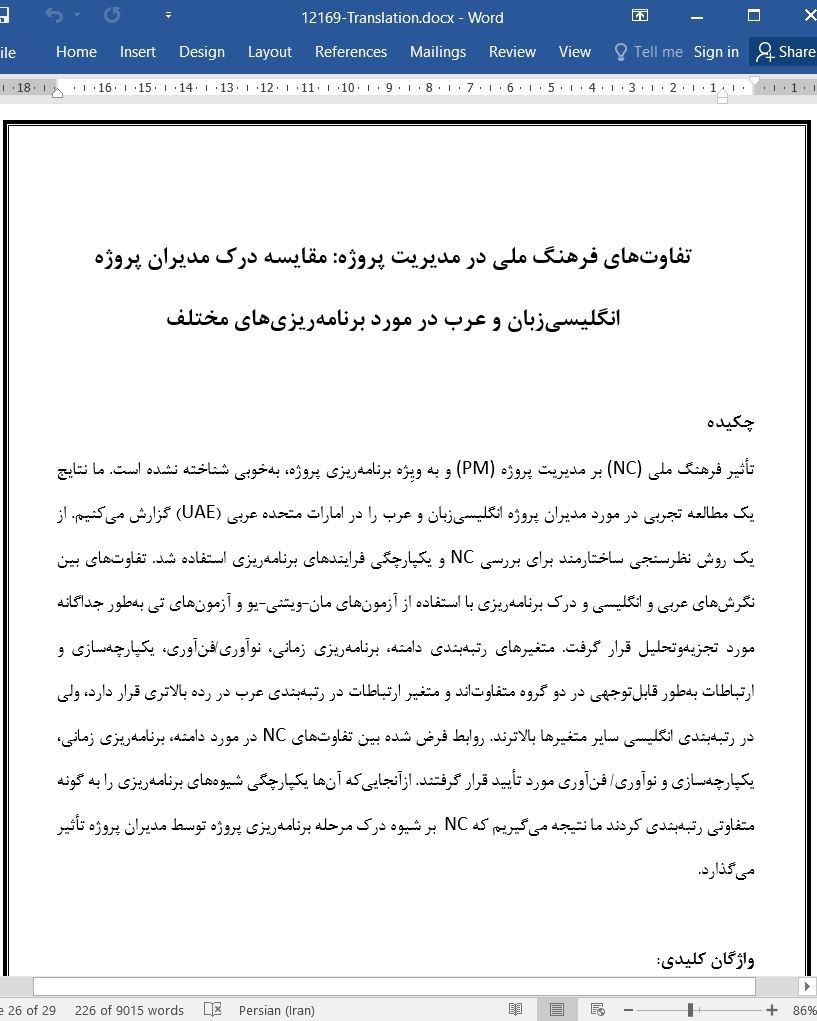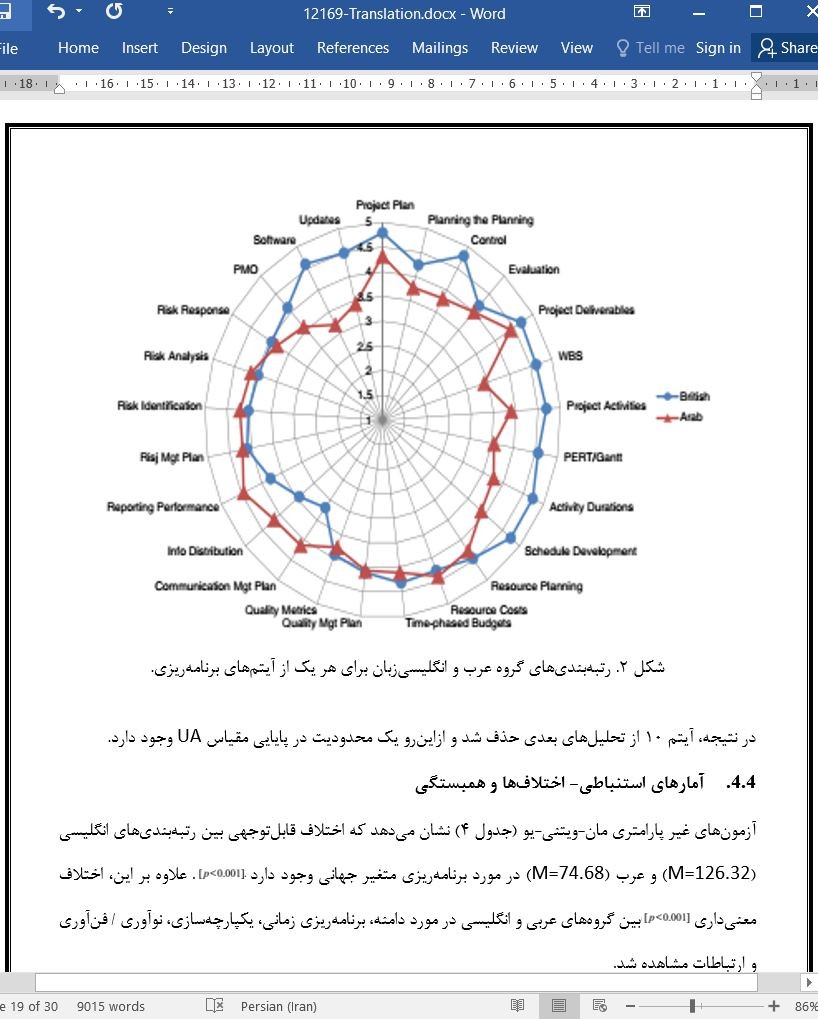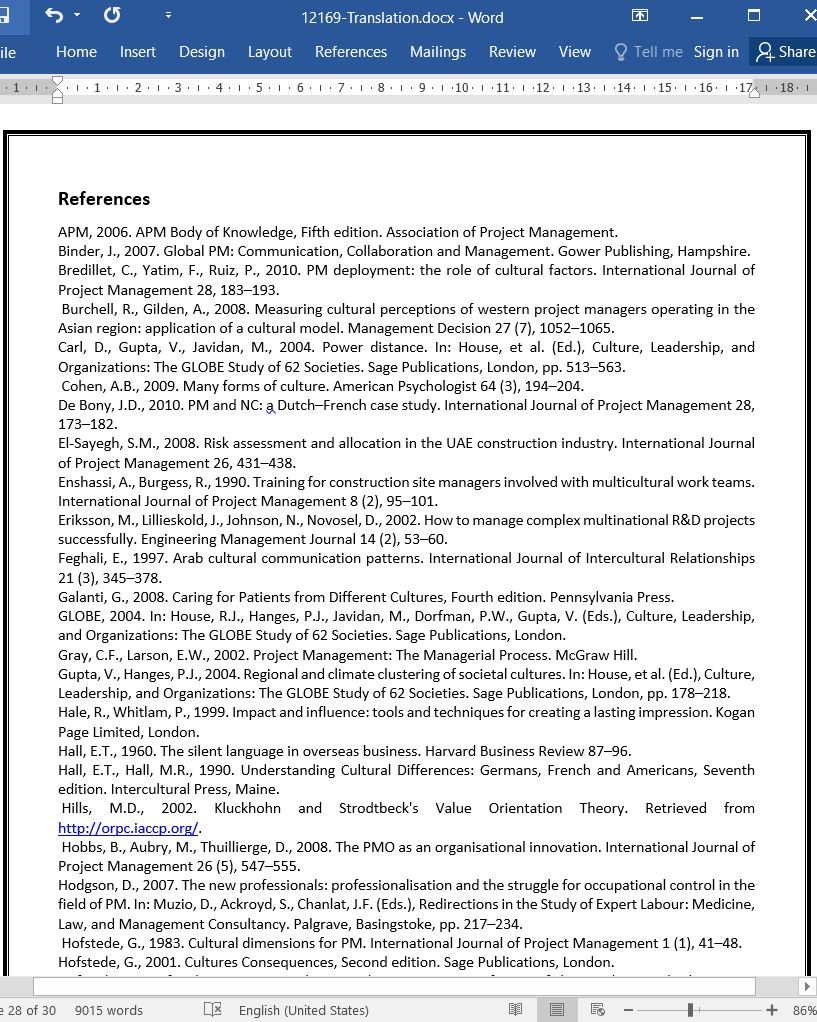
تفاوت های فرهنگ ملی در مدیریت پروژه
چکیده
تأثیر فرهنگ ملی (NC) بر مدیریت پروژه (PM) و به ویِژه برنامهریزی پروژه، بهخوبی شناخته نشده است. ما نتایج یک مطالعه تجربی در مورد مدیران پروژه انگلیسیزبان و عرب را در امارات متحده عربی (UAE) گزارش میکنیم. از یک روش نظرسنجی ساختارمند برای بررسی NC و یکپارچگی فرایندهای برنامهریزی استفاده شد. تفاوتهای بین نگرشهای عربی و انگلیسی و درک برنامهریزی با استفاده از آزمونهای مان-ویتنی-یو و آزمونهای تی بهطور جداگانه مورد تجزیهوتحلیل قرار گرفت. متغیرهای رتبهبندی دامنه، برنامهریزی زمانی، نوآوری/فنآوری، یکپارچهسازی و ارتباطات بهطور قابلتوجهی در دو گروه متفاوتاند و متغیر ارتباطات در رتبهبندی عرب در رده بالاتری قرار دارد، ولی در رتبهبندی انگلیسی سایر متغیرها بالاترند. روابط فرض شده بین تفاوتهای NC در مورد دامنه، برنامهریزی زمانی، یکپارچهسازی و نوآوری/ فنآوری مورد تأیید قرار گرفتند. ازآنجاییکه آنها یکپارچگی شیوههای برنامهریزی را به گونه متفاوتی رتبهبندی کردند ما نتیجه میگیریم که NC بر شیوه درک مرحله برنامهریزی پروژه توسط مدیران پروژه تأثیر میگذارد.
1. مقدمه
1.1. PM و NC
پروژهها اغلب متشکل از افراد و سازمانهایی از NCهای مختلف مانند تیمهای چند فرهنگی، مدیران خارجی، و شرکای بینالمللی هستند. برخی از نویسندگان بر نیاز به توجه بیشتر به تأثیر NC بر فرایندهای PM تأکید میکنند (Rees، 2008؛ Shore و Cross، 2005). برای مثال، Zwikael و همکاران (2005) در مطالعه خود در مورد NC و PM دریافتند که تفاوتهای فرهنگی زیادی در فرایندهای برنامهریزی وجود دارد و پیشنهاد دادند که تحقیقات بیشتری در سایر کشورها در این خصوص انجام شود. جالب اینجاست که Hodgson (2007:224) بر این باور است که انجمنهای PM در سطح ملی جای گرفتهاند و حرفهای گرایی به لحاظ ملی و فرهنگی محدود شده است. بنابراین، اگر انجمنهایی مانند PMI، ASAPM (ایالاتمتحده)، APM (انگلستان)، GPM (آلمان)، PMAJ (ژاپن) و IPMA همچنان به دنبال دستیابی به موقعیت حرفهای باشند، به نظر میرسد که تحقیقات NC حتی ضروری تر باشد.
6. نتیجهگیری
سؤال تحقیق ما این است که آیا تفاوتهای NC ، انتظارات متفاوتی را در مورد برنامهریزی پروژه ایجاد میکند یا خیر. ما نتیجه میگیریم که NC بر روشی که در آن یک مدیر پروژه مرحله برنامهریزی پروژه را درک میکند، تأثیر میگذارد. مطالعه ما استدلال Milosevic (1999) را تأیید میکند که میگوید شیوههای مشابه PM به گونه متفاوتی تعبیر میشوند و یا یافتههای Zwikael و همکاران (2005) که نشان میدهد مدیران پروژه از NCهای مختلف پروژههای مشابهی را اجرا میکنند اما آنها را به روشهای متفاوتی هدایت میکنند. این امر نشان میدهد که مدیران پروژه ممکن است درواقع برنامهها یا اسکریپتهای شناختی مختلفی از PM راجع به مرحله برنامهریزی داشته باشند (Milosevic، 2002؛ Shaw، 1990). به نظر میرسد که این امر برای روابط کاری، ارتباطات، و همکاری بین همه اعضای پروژه راجع به اجرا و برنامهریزی PM مهم باشد. برای مثال، Hall (1960) بر این باور بود که تعارضاتی ممکن است بین فرهنگهایی که دیدگاههای مختلفی از زمان دارند وجود داشته باشد، برای مثال تأخیر در کار ممکن است موجب پایین آمدن منافع یک مدیر پروژه انگلیسی شود، اما انجام سریع کارها و توجه زیاد به آینده میتواند یک مدیر پروژه عرب را فراری دهد. Hurn (2007) اظهار میدارد که سر رسیدهای مشخصشده در NC عرب به عنوان یک راهنما دیده میشود که ممکن است به دلیل جهتگیری آن نسبت به زمان حال باشد.
Abstract
The influence of National Culture (NC) on Project Management (PM) and specifically project planning is not well understood. We report the results of an empirical study of British and Arab project managers in the United Arab Emirates (UAE). A structured survey method was used to investigate NC and the integrity of Planning processes. Differences between the Arab and British attitudes and perceptions of planning were analysed using Mann– Whitney U tests and Independent t-tests. Ratings in Scope, Time planning, Innovation/Technology, Integration, and Communication variables significantly differed between both groups, with the Arab group rating Communication higher and the British group rating the remaining variables higher. Hypothesised relationships on NC differences were supported for Scope, Time planning, Integration and Innovation/Technology. Since they rated the integrity of planning practices differently we conclude that NC influences the way a project manager understands the planning stage of the project.
1. Introduction
1.1. PM and NC
Projects often comprise of people and organisations from different NCs such as multicultural teams, foreign managers, and international partners. A number of authors have called for more attention to be paid to the impact of NC on PM processes (Rees, 2008; Shore and Cross, 2005). For instance, Zwikael et al.'s (2005) study of NC and PM found that there were cultural differences in the intensity of planning processes and proposed that more research be carried out in other countries. Interestingly, Hodgson (2007: 224) argues that PM associations are nationally embedded and that professionalism is nationally and culturally circumscribed. Therefore, if associations such as the PMI, ASAPM (US), APM (UK), GPM (Germany) PMAJ (Japan) and IPMA continue to pursue professional status, NC research seems even more relevant.
6. Conclusion
Our research question asked whether differences in NC lead to different expectations regarding project planning. We conclude that NC influences the way in which a project manager understands the planning phase of a project. Our study supports Milosevic's (1999) argument that the same PM practices are interpreted differently and Zwikael et al.'s (2005) finding that project managers from different NCs run similar projects yet manage them in different ways. This suggests that project members may actually have different PM cognitive schema or scripts concerning the planning stage (Milosevic, 2002; Shaw, 1990). This seems important for working relationships, communication and collaboration between all project members concerning both PM planning and execution. For example, Hall (1960) argued that conflict may arise between cultures that have different appreciations of time, i.e. a delay may infer low interest to a British project manager, yet working too quickly or looking too much into the future may drive the Arab project manager away. Hurn (2007) states that deadlines are seen as a guide by the Arab NC, which may be due to a Present time orientation.
چکیده
1. مقدمه
1.1. PM و NC
1.2. تأثیر NC بر PM
2. زمینه مطالب و توجیهی برای طرح پیمایشی
2.1. مرحله برنامهریزی
3. روششناسی
3.1. طرح تحقیق
3.1.1. گزارهها و فرضیهها
3.2. مطالعه آزمایشی
3.3. نمونه مطالعه
3.4. ابزار مطالعه
3.5. متغیرهای جمعیت شناختی و شغلی
3.6. رویه
3.7. جمعیت شناختی
4. نتایج
4.1 جهت گیری فرهنگی
4.2. رتبهبندیهای برنامهریزی عرب و انگلیسی
4.3 . آلفای کرون باخ
4.4 آمارهای استنباطی- اختلافها و همبستگی
5. بحث
5.1. دامنه ( H1 تأیید شده است)
5.2. برنامهریزی زمانی (H2 تأیید شده است)
5.3. هزینه (H3 تأیید نشد)
5.4. ریسک (H4 تأیید شده است)
5.5. کیفیت (H5 تأیید نشد)
5.6. یکپارچهسازی (H6 تأیید شده است)
5.7. نوآوری/ فنآوری (H7 تأیید شده است)
5.8. ارتباطات (H8 تأیید نشد)
5.9. برنامهریزی
5.10. محدودیتهای مطالعه
6. نتیجهگیری
منابع
Abstract
1. Introduction
1.1. PM and NC
1.2. The influence of NC on PM
2. Literature background and justification for the survey design
2.1. The planning phase
3. Methodology
3.1. Research design
3.1.1. Propositions and hypotheses
3.2. Pilot study
3.3. Study sample
3.4. Study instrument
3.5. Demographic and career variables
3.6. Procedure
3.7. Demographics
4. Results
4.1. Cultural orientation
4.2. Arab and British planning ratings
4.3. Cronbach's alpha
4.4. Inferential statistics—differences and correlations
5. Discussion
5.1. Scope (H1 supported)
5.2. Time planning (H2 supported)
5.3. Cost (H3 not supported)
5.4. Risk (H4 not supported)
5.5. Quality (H5 not supported)
5.6. Integration (H6 supported)
5.7. Innovation/Technology (H7 supported)
5.8. Communication (H8 not supported)
5.9. Planning
5.10. Study limitations
6. Conclusion
References
- اصل مقاله انگلیسی با فرمت ورد (word) با قابلیت ویرایش
- ترجمه فارسی مقاله با فرمت ورد (word) با قابلیت ویرایش، بدون آرم سایت ای ترجمه
- ترجمه فارسی مقاله با فرمت pdf، بدون آرم سایت ای ترجمه



